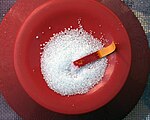Sodium hydrogen sulfate
|
|
|||
 |
|||
| Names | |||
|---|---|---|---|
|
IUPAC name
Sodium hydrogen sulfate
|
|||
| Other names
Sodium acid sulfate
Bisulfate of soda |
|||
| Identifiers | |||
|
|||
|
3D model (JSmol)
|
|||
| ChemSpider | |||
| ECHA InfoCard | 100.028.787 | ||
| EC Number | 231-665-7 | ||
| E number | E514 (acidity regulators, ...) | ||
|
PubChem CID
|
|||
| RTECS number | VZ1860000 | ||
|
|||
|
|||
| Properties | |||
| NaHSO4 | |||
| Molar mass | 120.06 g/mol (anhydrous) 138.07 g/mol (monohydrate) |
||
| Appearance | white solid | ||
| Density | 2.742 g/cm3 (anhydrous) 1.8 g/cm3 (monohydrate) |
||
| Melting point | 58.5 °C (137.3 °F; 331.6 K) (monohydrate) 315 °C (anhydrous) |
||
| Boiling point | decomposes to Na2S2O7 (+ H2O) at 315 °C (599 °F; 588 K) | ||
| 28.5 g/100 mL (25 °C) 100 g/100 mL (100 °C) |
|||
| Solubility | Insoluble in ammonia | ||
| Acidity (pKa) | 1.99 | ||
| Structure | |||
| triclinic (anhydrous) monoclinic (monohydrate) |
|||
| Hazards | |||
| Safety data sheet | External MSDS | ||
| R-phrases (outdated) | R34 R37 R41 | ||
| S-phrases (outdated) | S26 S36 S37 S39 S45 | ||
| NFPA 704 | |||
| Flash point | Non-flammable | ||
| Related compounds | |||
|
Other anions
|
Sodium sulfate | ||
|
Other cations
|
Potassium bisulfate | ||
|
Except where otherwise noted, data are given for materials in their standard state (at 25 °C [77 °F], 100 kPa).
|
|||
|
|
|||
| Infobox references | |||
Sodium bisulfate, also known as sodium hydrogen sulfate, is the sodium salt of the bisulfate anion, with the molecular formula NaHSO4. Sodium bisulfate is an acid salt formed by partial neutralization of sulfuric acid by an equivalent of sodium base, typically either in the form of sodium hydroxide or sodium chloride. It is a dry granular product that can be safely shipped and stored. The anhydrous form is hygroscopic. Solutions of sodium bisulfate are acidic, with a 1M solution having a pH of around 1.
One production method involves mixing stoichiometric quantities of sodium hydroxide and sulfuric acid which react to form sodium bisulfate and water.
A second production method involves reacting sodium chloride (salt) and sulfuric acid at elevated temperatures to produce sodium bisulfate and hydrogen chloride gas.
The liquid sodium bisulfate is sprayed and cooled so that it forms a solid bead. The hydrogen chloride gas is dissolved in water to produce hydrochloric acid as a useful coproduct of the reaction. Sodium bisulfate is also produced as a byproduct of the production of many other mineral acids via the reaction of their sodium salts with an excess of sulfuric acid:
In most cases, the acids produced have a lower boiling point than the reactants and are separated from the reaction mixture by distillation.
There are only two producers in the USA, one being Jones-Hamilton Co., who uses the sulfuric acid/sodium chloride process, which produces the anhydrous form. The other supplier, Jost Chemical, uses the sodium hydroxide/sulfuric acid method, which produces the monohydrate.
Sodium bisulfate is used primarily to lower pH. For technical-grade applications, it is used in metal finishing, cleaning products, and to lower the pH of water for effective chlorination in swimming pools and hot tubs. Sodium bisulfate is also AAFCO approved as a general-use feed additive, including companion animal food. It is used as a urine acidifier to reduce urinary stones in cats.
...
Wikipedia


